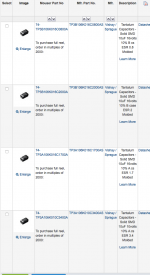Alex
Well-known member
I don't know if anyone is still paying attention to this post but I wanted to ask, what is ESR?
I found the Vishay IIfx mentioned, there are four 10uf 16V Vishay Tantalum Capacitors but why four, I see the ESR values that differ.
.8
2
1.7
3.4
I have heard of ESR meters.
To jump start this OT part of the discussion, if it continues I found the following:
The ESR rating of a capacitor is a rating of quality. A theoretically perfect capacitor would be lossless and have an ESR of zero. It would have no in-phase AC resistance. We live in the real world and all capacitors have some amount of ESR
Here is the link to the quote above.
Now, I know that this might be picking teeth here but this stuff is really interesting to me and I will have to read more on this but if any want to indulge me please do, I would love to get your take.
By the way, the fourth cap is 10 volts, I know I shouldn't buy that one. I won't be buying from mouser anyway but still …

I found the Vishay IIfx mentioned, there are four 10uf 16V Vishay Tantalum Capacitors but why four, I see the ESR values that differ.
.8
2
1.7
3.4
I have heard of ESR meters.
To jump start this OT part of the discussion, if it continues I found the following:
The ESR rating of a capacitor is a rating of quality. A theoretically perfect capacitor would be lossless and have an ESR of zero. It would have no in-phase AC resistance. We live in the real world and all capacitors have some amount of ESR
Here is the link to the quote above.
Now, I know that this might be picking teeth here but this stuff is really interesting to me and I will have to read more on this but if any want to indulge me please do, I would love to get your take.
By the way, the fourth cap is 10 volts, I know I shouldn't buy that one. I won't be buying from mouser anyway but still …

Last edited by a moderator:


